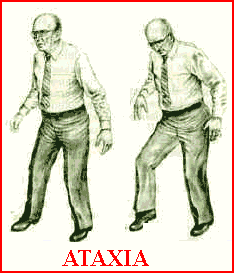Hereditary spastic ataxia,is a usually heredofamilial disease.It is characterized pathologically by atrophy of the cerebellum, cell loss in the dentate and olivary nuclei.
Clinical Features of Hereditary Spastic Ataxia
This is an uncommon form of spino cerebellar degeneration. It is usually hereditary with several clinical and pathologic variants.Clinically and pathologically, these variants represent an intermediate between Friedreich’s ataxia, which is principally spinal, and olivopontocerebellar degeneration, primarily a cerebellar disease. The age of onset varies according to the pedigree, and often may not occur until the fifth and sixth decades of life. The disease consists of a mixture of ataxia and spasticity. The onset is most usually characterized by ataxia of gait, which may progress to incoordination of the upper extremities.
There may be associated optic atrophy, ptosis, diplopia, and extraocular muscle palsies. Deep tendon reflexes are preserved and are often hyperactive, and ankle clonus and extensor plantar responses are frequently seen. In some patients spasticity may be the prominent finding. Unlike Friedreich’s ataxia, nystagmus and abnormalities of the skeleton are usually absent. Dementia may sometimes be prominent. Phenotypic variation of the disease within a family may be striking.
